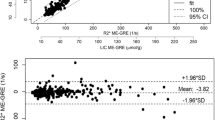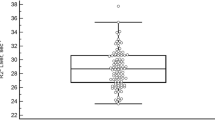Abstract
Objective
Assessment of iron content in the liver is crucial for diagnosis/treatment of iron-overload diseases. Nonetheless, T2*-based methods become challenging when fat and iron are simultaneously present. This study proposes a phantom design concomitantly containing various concentrations of iron and fat suitable for devising accurate simultaneous T2* and fat quantification technique.
Materials and methods
A 46-vial iron–fat–water phantom with various iron concentrations covering clinically relevant T2* relaxation time values, from healthy to severely overloaded liver and wide fat percentages ranges from 0 to 100% was prepared. The phantom was constructed using insoluble iron (II, III) oxide powder containing microscale particles. T2*-weighted imaging using multi-gradient-echo (mGRE) sequence, and chemical shift imaging spin-echo (CSI-SE) Magnetic Resonance Spectroscopy (MRS) data were considered for the analysis. T2* relaxation times and fat fractions were extracted from the MR signals to explore the effects of fat and iron overload.
Results
Size distribution of iron oxide particles for Magnetite fits with a lognormal function with a mean size of about 1.17 µm. Comparison of FF color maps, estimated from bi- and mono-exponential model indicated that single-T2* fitting model resulted in lower NRMSD. Therefore, T2* values from the mono-exponential signal equation were used and expressed the relationship between relaxation time value across all iron (Fe) and fat concentration as \({\text{Fe}} = - 28.02 + \frac{302.84}{{T2^{*} }} - 0.045\,{\text{FF}}\), with R-squared = 0.89.
Discussion
The proposed phantom design with microsphere iron particles closely simulated the single-T2* behavior of fatty iron-overloaded liver in vivo.






Similar content being viewed by others
References
Gupta CP (2014) Role of iron (Fe) in body. IOSR J Appl Chem (IOSR-JAC) 7:38–46
Andrews NC (1999) Disorders of iron metabolism. N Engl J Med 341(26):1986–1995
Brittenham GM, Badman DG (2003) Noninvasive measurement of iron: report of an NIDDK workshop. Blood 101(1):15–19
Batts KP (2007) Iron overload syndromes and the liver. Mod Pathol 20(1s):S31
Yokoo T, Yuan Q, Sénégas J, Wiethoff AJ, Pedrosa I (2015) Quantitative R2* MRI of the liver with Rician noise models for evaluation of hepatic iron overload: Simulation, phantom, and early clinical experience. J Magn Reson Imaging 42(6):1544–1559
Horng DE, Hernando D, Reeder SB (2017) Quantification of liver fat in the presence of iron overload. J Magn Reson Imaging 45(2):428–439
Yokoo T, Browning JD (2014) Fat and iron quantification in the liver: past, present, and future. Top Magn Reson Imaging 23(2):73–94
Kühn J-P, Meffert P, Heske C, Kromrey M-L, Schmidt CO, Mensel B, Völzke H, Lerch MM, Hernando D, Mayerle J (2017) Prevalence of fatty liver disease and hepatic iron overload in a Northeastern German population by using quantitative MR imaging. Radiology 28(3):706–716
Tipirneni-Sajja A, Krafft AJ, Loeffler RB, Song R, Bahrami A, Hankins JS, Hillenbrand CM (2019) Autoregressive moving average modeling for hepatic iron quantification in the presence of fat. J Magn Reson Imaging 50:1620–1632. https://doi.org/10.1002/jmri.26682
Lidbury JA (2017) Getting the most out of liver biopsy. Vet Clin Small Animal Pract 47(3):569–583
Ratziu V, Charlotte F, Heurtier A, Gombert S, Giral P, Bruckert E, Grimaldi A, Capron F, Poynard T, Group LS (2005) Sampling variability of liver biopsy in nonalcoholic fatty liver disease. Gastroenterology 128(7):1898–1906
Li TQ, Aisen AM, Hindmarsh T (2004) Assessment of hepatic iron content using magnetic resonance imaging. Acta Radiol 45(2):119–129
Sirlin CB, Reeder SB (2010) Magnetic resonance imaging quantification of liver iron. Magn Reson Imaging Clin N Am 18(3):359–381
Bowen CV, Zhang X, Saab G, Gareau PJ, Rutt BK (2002) Application of the static dephasing regime theory to superparamagnetic iron-oxide loaded cells. Magn Reson Med 48(1):52–61
Yu H, Shimakawa A, McKenzie CA, Brodsky E, Brittain JH, Reeder SB (2008) Multiecho water-fat separation and simultaneous R 2* estimation with multifrequency fat spectrum modeling. Magn Reson Med 60(5):1122–1134
Clark PR, Chua-anusorn W, St. Pierre TG (2003) Bi-exponential proton transverse relaxation rate (R 2) image analysis using RF field intensity-weighted spin density projection: potential for R 2 measurement of iron-loaded liver. Magn Reson Imaging 21(5):519–530
Bernard CP, Liney GP, Manton DJ, Turnbull LW, Langton CM (2008) Comparison of fat quantification methods: a phantom study at 30T. J Magn Reson imaging 27(1):192–197
Hines CD, Yu H, Shimakawa A, McKenzie CA, Brittain JH, Reeder SB (2009) T1 independent, T2* corrected MRI with accurate spectral modeling for quantification of fat: validation in a fat-water-SPIO phantom. J Magn Reson Imaging JMRI 30(5):1215–1222
Reeder SB, Hernando D, Sharma S (2016) Phantom for iron and fat quantification magnetic resonance imaging. United States Patent
McMullan D (1995) Scanning electron microscopy 1928–1965. Scanning 17(3):175–185
Reinoso RF, Telfe BA, Rowland M (1997) Tissue water content in rats measured by desiccation. J Pharmacol Toxicol Methods 38(2):87–92
Hernando D, Cook RJ, Diamond C, Reeder SB (2013) Magnetic susceptibility as a B0 field strength independent MRI biomarker of liver iron overload. Magn Reson Med 70(3):648–656
Fukuzawa K, Hayashi T, Takahashi J, Yoshihara C, Tano M, Ji Kotoku, Saitoh S (2017) Evaluation of six-point modified dixon and magnetic resonance spectroscopy for fat quantification: a fat-water-iron phantom study. Radiol Phys Technol 10(3):349–358
Bydder M, Hamilton G, de Rochefort L, Desai A, Heba ER, Loomba R, Schwimmer JB, Szeverenyi NM, Sirlin CB (2018) Sources of systematic error in proton density fat fraction (PDFF) quantification in the liver evaluated from magnitude images with different numbers of echoes. NMR Biomed 31(1):e3843
Storey P, Thompson AA, Carqueville CL, Wood JC, de Freitas RA, Rigsby CK (2007) R2* imaging of transfusional iron burden at 3 T and comparison with 1.5 T. J Magn Reson Imaging 25(3):540–547
Meloni A, Positano V, Keilberg P, De Marchi D, Pepe P, Zuccarelli A, Campisi S, Romeo MA, Casini T, Bitti PP, Gerardi C, Lai ME, Piraino B, Giuffrida G, Secchi G, Midiri M, Lombardi M, Pepe A (2012) Feasibility, reproducibility, and reliability for the T* 2 iron evaluation at 3 T in comparison with 1.5 T. Magn Reson Med 68(2):543–551
Yamamura J, Keller S, Grosse R, Schoennagel B, Nielsen P, Wang ZJ, Graessner J, Kooijman H, Adam G, Fischer R (2016) Iron measurements by quantitative MRI-R2* at 3.0 and 1.5 T. In: ISMRM
Doyle EK, Toy K, Valdez B, Chia JM, Coates T, Wood JC (2017) Ultra-short echo time images quantify high liver iron. Magn Reson Med. https://doi.org/10.1002/mrm.26791
Krafft AJ, Loeffler RB, Song R, Tipirneni-Sajja A, McCarville MB, Robson MD, Hankins JS, Hillenbrand CM (2017) Quantitative ultrashort echo time imaging for assessment of massive iron overload at 1.5 and 3 Tesla. Magn Reson Med. https://doi.org/10.1002/mrm.26592:n/a-n/a
Acknowledgements
The authors would like to thank Hamid Emadi for help in preparing the phantom, Anahita Fathi Kazerooni for her scientific editing and comments on the manuscript. Imaging for this work was performed at National Brain Mapping Laboratory (NBML).
Funding
This phantom study has been supported by Tehran University of Medical Sciences & Health Services Grants 27331 and 32965.
Author information
Authors and Affiliations
Contributions
NM was responsible for study conception and design, data collection, analysis and interpretation of data, and drafting the manuscript; MM helped with the interpretation of data and critical revision; HH designed the study conception and acquisition of data; HS was responsible for protocol/project development of the framework and critical revision.
Corresponding author
Ethics declarations
Conflict of interest
The authors declare that they have no conflict of interest.
Ethical approval
This article does not contain any studies with human participants or animals performed by any of the authors.
Additional information
Publisher's Note
Springer Nature remains neutral with regard to jurisdictional claims in published maps and institutional affiliations.
Rights and permissions
About this article
Cite this article
Mobini, N., Malekzadeh, M., Haghighatkhah, H. et al. A hybrid (iron–fat–water) phantom for liver iron overload quantification in the presence of contaminating fat using magnetic resonance imaging. Magn Reson Mater Phy 33, 385–392 (2020). https://doi.org/10.1007/s10334-019-00795-7
Received:
Revised:
Accepted:
Published:
Issue Date:
DOI: https://doi.org/10.1007/s10334-019-00795-7




